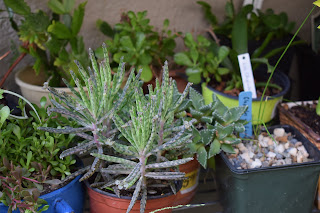Those regular inhabitants of the Bay Area know that autumn can often bring us our nicest weather and our gardens are often beneficiaries of that late in the year warmth. If one happens to have plants that are late summer and fall bloomers, those gardens can often shine right now, while gardens in colder climates are starting to wind down.
Today's photos gave a taste of that autumn splendor, with flowers and foliage alike shining.
Arum dioscoridis. If this spathe looks sort of familiar, that's because it looks a lot like those of several Arisaemas. Both belong to the Arum family so there's the explanation. I waited 3 years for this first spathe so it's cigars for everyone!
It's still small but this Monkey Puzzle tree (Araucaria angustifolia) is making steady growth.
I wasn't sure it would work, growing flowers out of the side opening on my hedgehog planter but have no fear. Success.
Monardella odoratissima. Though this form of Coyote mint is hard to find, it has proven to be an amazing bloomer. Butterflies love it of course but so do bees. And that scent is so lovely.
Punica granatum Dwarf. This dwarf pomegranate has been a real joy, blooming while still young and even producing a few fruits (though it is considered an ornamental).
Oxalis latifolia. This beautiful shamrock oxalis provides a nice splash of color in my dry garden bed.
My cat Phoebe on the prowl. "Here, mousey, mousey!"
Here's a side angle view of my dry garden bed. The large plant in the right front is an Aloe striata.
It took a couple of years to get established but my Grevillea Superb is off and running.
Hesperoyucca whipplei. Formerly known as Yucca whipplei, this guy's upright spines are not yet deadly. Love that steel blue color.
Aloe rooikappie. This South African aloe is a prolific bloomer.
Thunbergia battiscombei. The so-called 'blue thunbergia' is just getting going, blooming wise. Less of a vine than most Thunbergia, it forms a scandent bush.
Correa species Orange. This Aussie native is a reliable bloomer, putting out a great many small tubular orange flowers in the fall.
Nothing says 'red' like the flowers on a Bouvardia ternifolia! Hummers love them!
My favorite new succulent, this Kalanchoe tubiflora has little tubes at the ends of each branch.
It took forever but my Duranta Gold Mound is now fully established and has, in fact, outgrown its intended size of 4-6'.
The jury is still out on whether this plectranthus is P. oertendahlii or something else. I love the silver patterning on the leaves.
My Begonia Irene Nuss went crazy this year with a bevy of pink-flowering clusters. Happy, happy!
At the other end of the spectrum, I've never been able to make my Begonia luxuriens happy. And it has yet to bloom, though most grow this palm-leaf begonia for its foliage.
There was no variety name tag in this pot of Agastache so not sure of its ID. No matter. Very pretty..
Median strip #1. I've planted out all three median strips in front of our property, each with a combination of plants in the ground and in pots.
The phoenix. My Berberis Orange Rocket was all but dead when I pruned it back hard, moved it into more sun and fed it. It's bounced back gloriously!
Lobelia and Cushion bush. These guys were great choices for filling in a small spot. Neither will get big and I think they complement each other.
Cunonia capensis. The so-called Butterknife tree puts out these fuzzy bottlebrush-like blooms in late summer. Wonderful!
Lepechinia hastata (Pitcher sage). Almost the perfect plant - tough, beautiful, long blooming, with fragrant foliage.
My Azalea Court Jester seems to be a fall blooming variety. It doesn't get started until August.
Calaminthes nepetoides. This relative of catmint, sometimes called calamint, puts on an impressive blooming show in late summer.
Neoregelia 'Marcon.' One nice thing about bromeliads is that they're interesting year round. That's because it's the foliage that's the star attraction.
Begonia Gryphon. This hybrid begonia has yet to bloom in its first 6 years but no matter, it has such interesting foliage.
Here's closeup of a panicle of Begonia Irene Nuss flowers.
Though not the best photo - the flower isn't in perfect focus - my Haemanthus albiflos was still worth including. A much more reliable bloomer than it's Blood lily species mate H. coccineus, it blooms faithfully each year.
This eye-catching new fern (Phlebosia Nicolas Diamond) is said to be cross of two fern genera - Phlebodium and Pyrrosia. Lovely!





















































